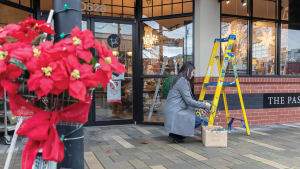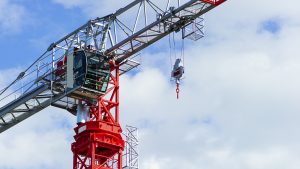One sunny summer morning a young man looking for work drives up to a suburban construction site and lucks out. He’s immediately hired as a “back-hoe guy.”
But maybe he’s not so lucky, because this is no ordinary job site.
A fellow worker is cutting plywood and in a moment of inattention the saw slices into his foot.
Then, a carpenter who is hammering wood pounds a nail clean through his thumb.
Seconds later a third worker falls off the roof and is impaled on an upright piece of metal.
This is followed by a series of increasingly horrifying and grisly mishaps.
Fortunately, these events didn’t actually take place on a real work site.
They were performed by actors and are part of a three-minute WorkSafeBC video called Standing on the Edge (Graphic Content!)
The tag line at the end of the video is “Always think about safety. You and your family depend on it.”
The professional-quality video, which has received more than 275,000 hits, is available on WorkSafeBC’s YouTube channel (see below).
According to WorkSafeBC spokesperson Erica Simpson, the agency produces videos for many industries, including construction.
“We have about 400 health and safety videos available to view and download on worksafebc.com and about 600 videos on our YouTube channel, which has over 42 million views and 56,000 subscribers,” Simpson said. “Our YouTube construction videos playlist has over 100 videos.”
The videos cover such topics as fall protection, ladder safety, women in trades, bullying, electrical hazards, safety around mobile equipment and the safe use of tools.
The videos range in duration from 15 seconds to 20 minutes. Many, such as Standing on the Edge, run around three minutes.
In some videos, a realistic-looking accident is followed by – whew- it didn’t really happen, because the apparent victim is actually a real professional and followed all the right safety guidelines.
Other videos follow a different model.
“We produce many different styles,” said Simpson. “They include real incident investigation slide show-style videos, short documentaries, animated videos, traditional training videos, worker and employer profile videos, humorous videos and awareness videos.”
Many WorkSafeBC videos are dubbed into other languages. And often they’re translated into seven languages as closed captions in YouTube: French, Spanish, Vietnamese, Punjabi, Korean, Chinese Simplified and Chinese Traditional.
In addition to hiring actors and stunt persons when they’re needed, WorkSafeBC uses real workers and employers in their videos.
The agency decides which subjects will be covered in videos following recommendations by its High Risk Strategies (HRS) department.
Based on the incidence of serious injuries and work-related deaths, HRS focuses on four industries: forestry, health care, manufacturing and construction.
In addition to HRS, WorkSafeBC identifies sectors and subsectors with a high risk of serious workplace injury.
In 2019, some 13 high-risk sectors have been identified, such as asbestos, confined space, cranes, and bullying, harassment and discrimination.
Simpson says the way WorkSafeBC makes videos is unique.
“We have audio-visual professionals in-house, while similar organizations produce videos with external ad agencies and contractors,” she said. “Our in-house team allows us to create more prevention resources than similar organizations.”
The production process consists of a series of steps from the time the idea for a video has been hatched until it’s posted online for viewing, says Janice Twiss, WorkSafeBC manager of experience and marketing. These steps are:
- Request – The process begins with the decision to create awareness about a specific health and safety issue. The topic is proposed by an internal subject matter expert and/or industry partner.
- Discovery – The proposed topic is reviewed to determine if it would benefit from a video treatment, and if this is the best outreach mechanism for the audience. If so, we then decide on the most engaging style of video for the topic and audience.
- Pre-production – This includes script writing, storyboarding (graphic representation of the idea), casting and location scouting. It can take several months.
- Production – This ranges from animation to small-scale and full-scale shoots.
- Post-production – The project passes to an editor, who works with the director to assemble a rough cut.
- Reviews and approvals – There are several stages of internal and partner reviews and approvals before a video is ready to present.
- Web publishing – Once completed, videos are posted to WorkSafeBC’s YouTube channel and worksafebc.com.
- Promotion – Published videos are shared on social media, events and campaigns and WorkSafeBC industry partners.
“The AV (audio-visual) team is part of our experience, marketing and insights department,” said Twiss. “We have three AV staff, consisting of two media producers and a photographer, and we work with various contractors and internal teams as required.”









Recent Comments
comments for this post are closed